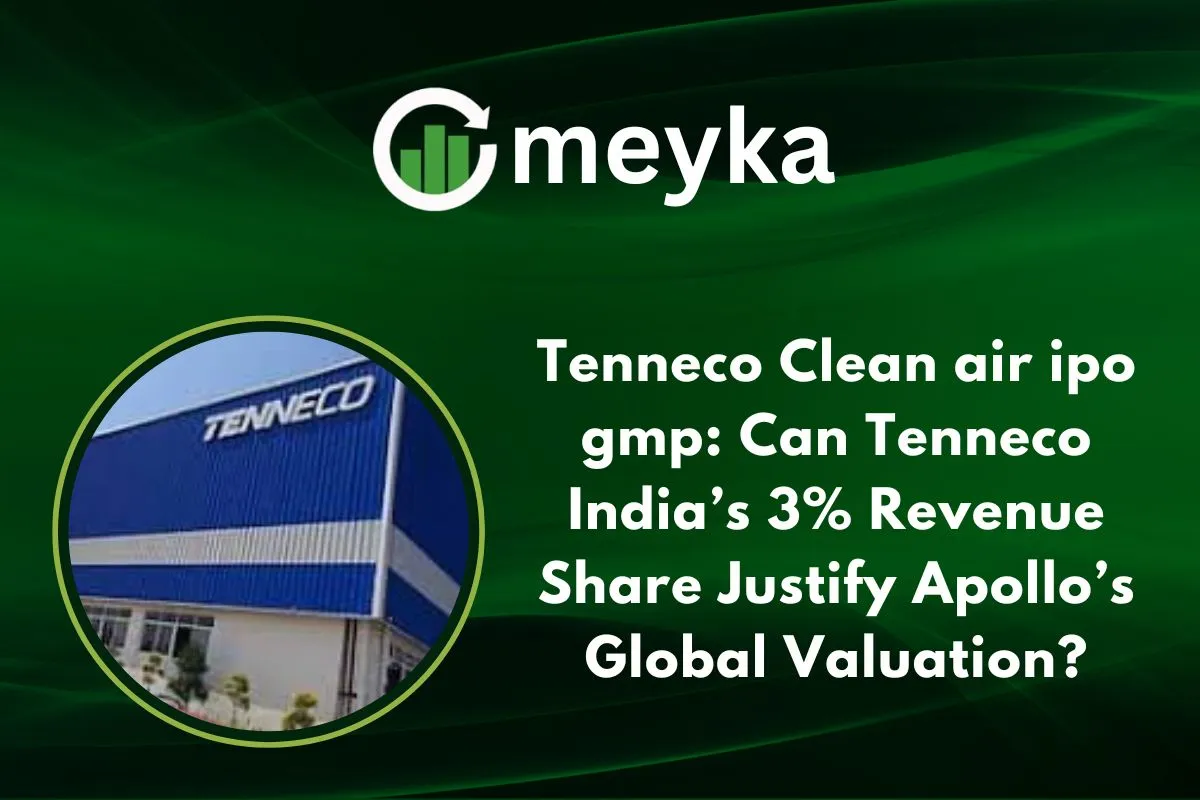Tenneco clean air ipo gmp: Can Tenneco India’s 3% Revenue Share Justify Apollo’s Global Valuation?
We are watching the launch of the Tenneco Clean Air India Ltd (Tenneco India) IPO with interest. The company is set to raise around ₹3,600 crore via an offer for sale, at a price band of ₹378‑397 per share. What catches our eye is this: India contributes only about 3% of the global revenue of its parent, Tenneco Inc. (now held by Apollo Global Management). At the same time, the grey market premium (GMP) for the IPO is showing strong signals, indicative of high investor excitement. We’ll explore how Tenneco India’s business stacks up. We’ll look at the GMP trend, compare revenue shares, dig into the market outlook, and ask: Does the small Indian slice truly justify the global valuation?
Overview of Tenneco Clean Air India
Tenneco India is part of Tenneco Inc., a U.S.-based global auto components player. The Indian unit manufactures “clean air & powertrain” solutions and advanced ride technologies (suspension, shock absorbers) for vehicles. It serves both domestic OEMs (original equipment manufacturers) in India and exports to over 20 countries.
As some key stats: in FY 25, the company reported revenue of about ₹4,890 crore, with robust margins (EBITDA margin ~16.7%) and profit after tax of about ₹553 crore. Importantly, one recent analysis noted that India represents only ~3 % of the parent company’s global revenue. Thus, while Tenneco India is well‑embedded in the auto components ecosystem, it is a small part of the global picture.
Tenneco India Revenue vs Global Valuation
We now compare the Indian revenue share with the global valuation of the parent company.
When Apollo Global Management took Tenneco private in 2022, the global business was valued at tens of billions of dollars. Meanwhile, Tenneco India’s contribution is only around 3 % of that global revenue picture. This raises a key question: can that 3 % justify the kind of valuation the global parent has? From the IPO side: at the upper band of ₹397, the implied P/E was ~29× and EV/EBITDA ~19×, considered moderate relative to industry peers. But analysts flag a few caveats: heavy reliance on internal combustion engine (ICE) technologies, limited fresh capex, and a customer concentration risk.
In short: Solid business in India, yet a small slice of a global pie. Whether the valuation is fully justified depends on growth ahead, not just current numbers.
Grey Market Premium (GMP) Analysis
Let’s talk about the “Tenneco Clean air ipo gmp”. That’s the topic many retail investors are watching. GMP refers to the premium at which the shares are trading in the unofficial grey market before listing. It gives a sense of investor sentiment. For this IPO, GMP has been reported in the range of ₹61 per share, roughly a ~15.4 % premium over the upper band price of ₹397, implying a potential listing price around ₹458. In earlier reports, the GMP was around ~24% according to some sources.
What does this tell us? There’s strong interest from investors ahead of listing. It suggests positive sentiment for Tenneco India’s business. However, GMP is unofficial and can swing. It doesn’t guarantee long‑term performance. Also, because the IPO is entirely an offer for sale (OFS), the company isn’t using IPO funds for growth. That means listing gains may be possible, but long‑term growth depends on operations. As we interpret the GMP, we should keep in mind: good signal, but not the full story.
Market Trends and Sector Outlook
We now zoom out to look at broader trends in the auto component and clean air space, globally and in India. In India, the auto component industry (including OEMs and aftermarket) grew at ~13.4 % CAGR in the five years till FY 25, reaching about ₹8,622 billion in 2025. Regulation‑wise, stricter emission norms (Bharat Stage VI+, heavy trucks) and the push for cleaner mobility create opportunities for companies like Tenneco India. On the flip side: The shift toward electric vehicles (EVs) may reduce demand for certain clean air/exhaust systems tied to internal‑combustion engines. Analysts view this as a structural risk. For Tenneco India specifically, its strong OEM relationships and export reach are positives. But dependence on ICE technology and major clients is a caution.
In our view, the sector outlook is favourable for the near‑to‑medium term, especially in India’s heavy‑vehicle and commercial‑vehicle space. But beyond that, adaptation will matter.
Can India’s Revenue Justify the Global Valuation?
So we arrive at the core question: Is Tenneco India’s ~3% revenue share enough to justify the global valuation being placed on the parent company? The answer is: “It depends.” On the positive side, Tenneco India brings strong returns, leadership in its field, and a clean balance sheet. Analysts commend its business fundamentals. However, when we compare scal, a 3% contribution means most of the global value lies outside India. So the growth story must come from scaling up India operations, expanding into EV‑friendly segments, increasing exports, and possibly new technologies.
Also important: With the IPO being an OFS (no fresh funds), the company will rely on existing business to deliver growth rather than fresh capital injection. That limits immediate upside potential. The GMP indicates investor optimism in the short term. But for long-term value, the question remains: Can Tenneco India grow substantially beyond its current base?
If yes, then the valuation makes sense. If growth stalls due to EV disruption or client concentration, the global valuation case weakens.
Conclusion
In conclusion, from the market perspective, see Tenneco Clean Air India as a well-run business with a strong market position and clean financials. The grey market premium, or Tenneco Clean Air ipo gmp, indicates healthy investor interest and optimism ahead of listing. However, with India contributing only about 3% of the parent company’s global revenue, the valuation of Apollo’s global business depends on more than just this unit. The sector outlook in India is promising for now, but structural changes like EV adoption and client concentration remain risks. For investors, short-term listing gains may be appealing, yet long-term value will rely on Tenneco India’s ability to grow, innovate, and adapt to the changing automotive landscape. Overall, a balanced approach considering both GMP and fundamental growth potential is essential before investing.
FAQS
A high GMP shows strong demand for an IPO before listing. But it is not always good. Prices can fall after listing if fundamentals are weak or overhyped.
A moderate GMP of 10–20% is usually considered healthy. It shows good investor interest without too much hype. Too high GMP can mean overvaluation and short-term risk.
Tenneco’s stock dropped due to profit booking, weak market sentiment, or concerns about a small revenue share in India. Investors often react to earnings, GMP swings, or global automotive trends.
Disclaimer:
The content shared by Meyka AI PTY LTD is solely for research and informational purposes. Meyka is not a financial advisory service, and the information provided should not be considered investment or trading advice.






